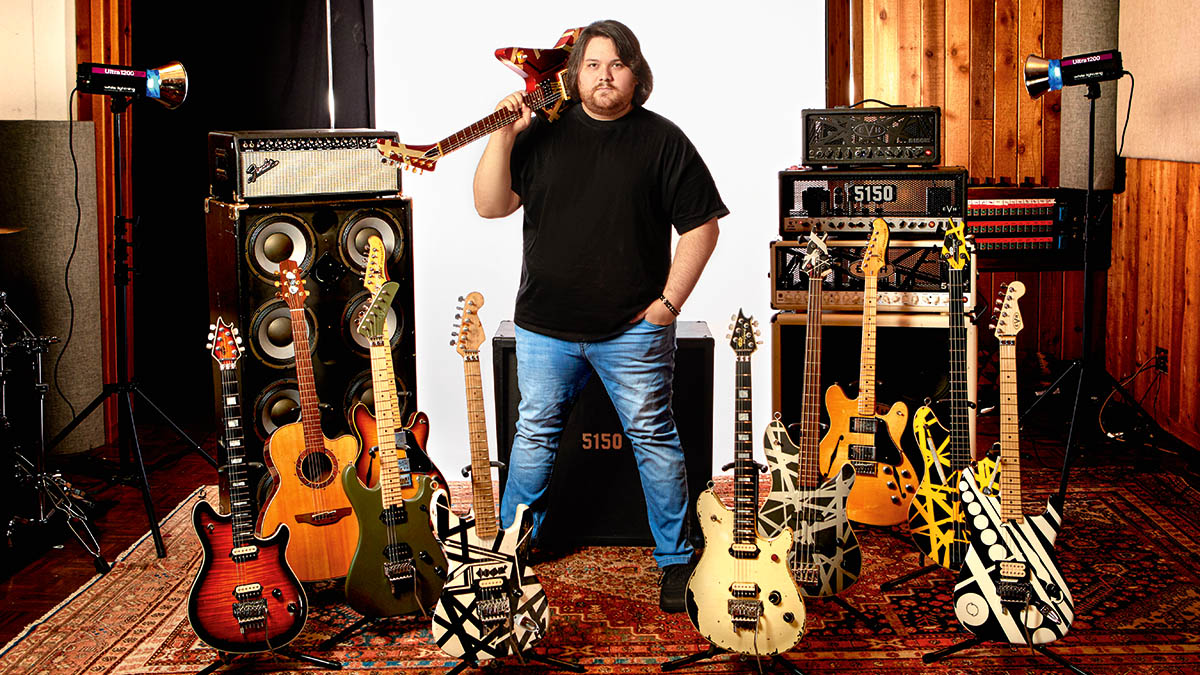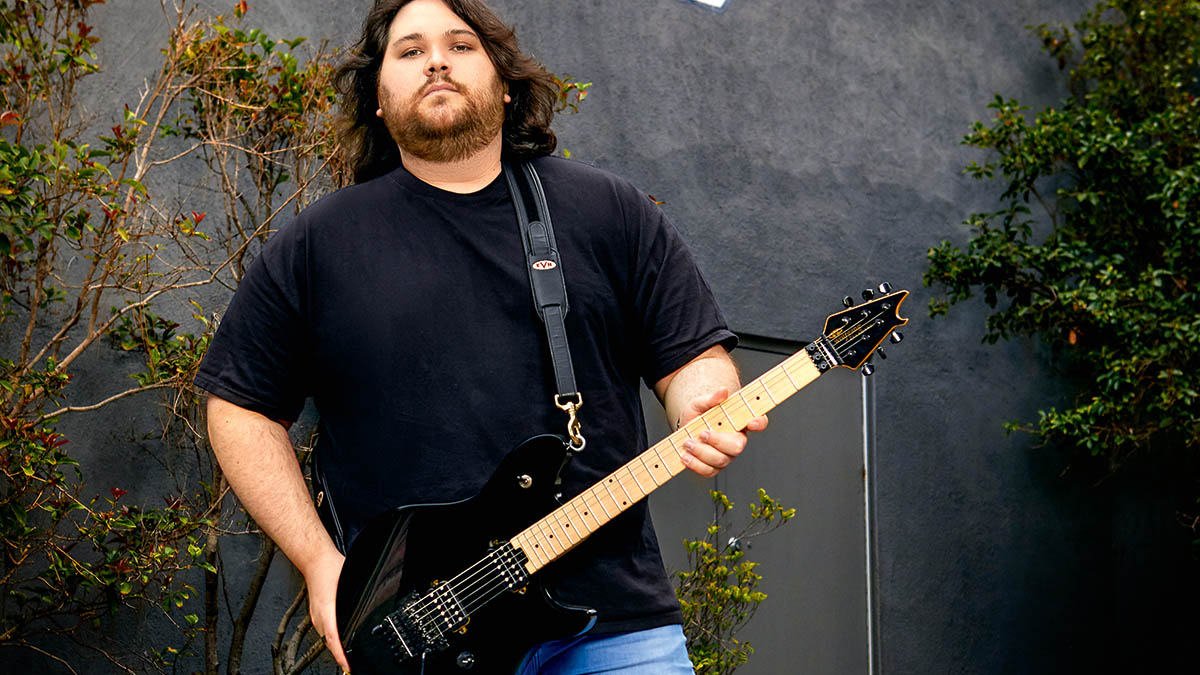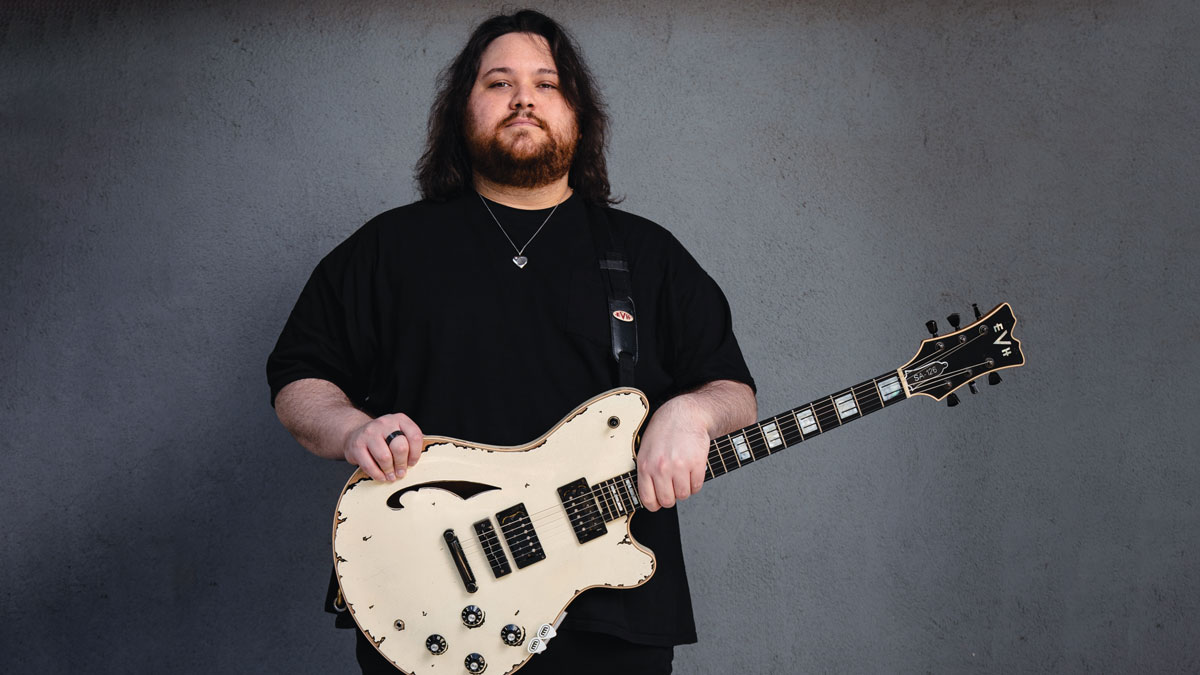Wolfgang Van Halen: “You can feel the history emanating out of the Frankenstein. Picking up that guitar is almost a religious experience”
With a new album and a new signature EVH guitar, 2023 is shaping up to be another big year for Wolfgang Van Halen. He tells us what’s in store – and recalls the time he broke one of his dad’s guitars

Recent years have witnessed many a guitar hero in the making, but few have felt as genuinely electrifying as Wolfgang Van Halen. Of course, there’s the genetic advantage – his father was undoubtedly the most important rock guitarist to follow on from the likes of Hendrix and Page. And Wolfgang had also played bass guitar in the Van Halen lineup for the band’s final album and consecutive world tour, not long after his 20th birthday.
But on the singer/guitarist’s 2021 debut as Mammoth WVH – which he composed, sung and performed singlehandedly – Wolfgang proved his talents alone were enough to stop people in their tracks and take notice.
The year that followed included many high-profile dates with Guns N’ Roses and Alter Bridge, as well as those unforgettable performances with Dave Grohl, Justin Hawkins and Josh Freese at the two tribute show for the late Foo Fighters drummer Taylor Hawkins.
And as Wolfgang tells TG, 2023 looks set to be even more exciting, from his new signature instrument with EVH Guitars (the Fender-owned brand he co-runs with longtime Van Halen tech Matt Bruck), a new album (which includes his first piano ballad) and then the small matter of a world tour with Metallica...
You were mainly using your EVH SA-126 prototype over the course of 2022. We’re excited to see the official release...
“Oh, it’s been a very exciting project! I think we’re nearing completion now. We’ve been working on it for a few years, revising the way it’s built so manufacturing can be easier, making little changes here and there. There’s an E-hole instead of an F-hole for Pop – and we’ve made that a tiny bit bigger and lined it up with the pickups.
“It’s just been little innocuous things that people won’t really notice, but we’re very critical of everything so we’ve been trying to figure out the right kind of updates. I can’t exactly guarantee when it will be available, but we’re getting really close. This next year will be the last crash-testing phase for the guitar, given all the touring we have planned. I’m very excited about 2023!”
Get The Pick Newsletter
All the latest guitar news, interviews, lessons, reviews, deals and more, direct to your inbox!
The name of the guitar refers to your Dad’s birthday, January 26... much like the Van Halen track 316 was in reference to your birthday.
“Yeah! But at the same time, if somebody were to pick up the guitar and see 126 written on it, they wouldn’t immediately think it’s some sort of tribute. I think it’s kinda hidden within it, and that’s what I like most. The dedication to my dad isn’t what overrides the entire thing. The most important aspect is that it’s an amazing instrument that all kinds of players can pick up and enjoy.”
So in what ways does a semi-hollow affect your playing and approach to tone?
“I guess it all comes down to how we approached the recording process way back in 2015, which is when I started doing the initial guitar tracking for the debut. There was a bunch of experimentation to try and figure out my tone.
To us, Frankenstein is quite literally the most famous guitar in the existence of music, where to my dad it was this little piece of junk he put together
“It was an intentional move to not sound exactly like my dad. I wanted to be my own person with my own sound. That’s what drove me to semi-hollow guitars, embracing a different kind of vibe.
“But I also enjoy the modern approach, so basically it’s the classic sound of a 335 or semi-hollow merged with what the brand is known for: high performance, shreddy types of guitars.
“The neck is super thin and wide, which is not something you’d normally find on a 335. They usually have fuckin’ baseball bats for necks, which is awesome if that’s what you’re into. When it comes to playing quick passages and stuff like that, this is an instrument that didn’t exist but now does! That’s another reason why I’m so excited about it.”
As for the pickups, are they specifically voiced for semis and noticeably different to the ones found on solid-body Wolfgang models?
“If I’m not mistaken, the typical output of a classical semi-hollow is around 8.2k. We basically made a standard, hotter and hottest version – then going back and forth on tour, trying to figure out which we liked best.
“We ended up landing in the middle because it keeps the full tone of the guitar while not going too overboard, because that’s the dangerous thing about semi-hollows, you worry about whether it will feed back too much. We wanted to push things to the limit without making it impossible to control.”
What kind of DCR will they be reading, then?
“I think it’s around 10.2k. It’s not too hot, but it’s still hotter than your average PAF-style pickup found on those classic guitars. It’s hard to remember exactly. After just getting back from a seven-week tour, I’m sort of wacky in the brain right now!”

The guitar is like a hybrid of a 335 and the Fender Starcaster you were playing in the Don’t Back Down video. Another Easter egg is that the inlays say W, E or M depending on which way you’re looking at them... genius!
“Yeah, they kind of work three ways. That was an amazing coincidence and something I found to make the guitar even cooler!”
You used your Dad’s vintage ES-335 on the debut album, though it ended up getting broken. What happened, exactly?
“Yeah, that was during the first round of tracking. The first guitars I cut were with that one and playing that guitar is what made me realise I wanted to explore semi-hollows more, because I never used one before then. It was an old guitar that my dad had, I believe either a ’58 or ’59.
“We were tuning it and as I was turning one of the pegs, it crumbled in my hands because it was so old. It basically just disintegrated and I was like, ‘Ooooh, that’s not good!’ And Dad thought it was hilarious. He was like, ‘Wow, that shit’s old, it doesn’t matter!’ We got it fixed up and luckily it stayed in tune enough to finish the track, which was nice. Playing that vintage 335 made me fall in love with the semi-hollow sound.”
Let’s get to the new music. It sounds like you’re almost finished and once again you played everything on the album...
“Yeah, I’ve almost finished it! Some people try to turn me playing everything into a negative thing, which surprises me! It’s like they think I won’t let other people play on it or something like that. But really this is what Mammoth is and always has been – it’s my artistic expression.
“I’ve been in bands before where you collaborate and that’s not what this is. I have a live band but in the studio I do everything and have a fun time doing it. I enjoy being able to express myself musically in every avenue.”
So what can we expect? Is there anything different in terms of style?
“It will always sound a bit similar, I guess, because the same dude is writing it! But I think on this current material, you can hear me challenging myself a bit more. I’ve gotten more confident and I know what the project is now, rather than trying to figure out what it was from the start, like on the first one.
“On the debut there was this width of what the project was – on the left you had songs like Distance and Circles, those softer vibes, and on the right you had tracks like Stone and The Big Picture. In the middle, there were songs like Mammoth or Epiphany and stuff like that. What I want to do with this album is widen what that breadth is.
“Further left, for example, there’s a song that’s all on piano... so it has more of a softer vibe. But on the right, there’s some really heavy sh*t in comparison to the debut! That’s what I find really exciting, it’s fun to stretch the definition of Mammoth on both sides.”

And what are the main differences in terms of gear?
“Well, the main thing which stole the show is the SA-126. It’s on pretty much the entirety of the album. We were almost surprised as we kept going through. It was like, ‘Wow, okay this works for this, too’ and ‘Oh my god, this works really well again over here!’
“From the cleans to the really heavy stuff, it sounded crazy! The only thing I have left to do is track the guitar solos, so what I want to do is go through some of Pop’s notable guitars and do a solo with each of them. Guitars like the Frankenstein or the Shark, stuff like that.”
Very nice! Because when we last spoke, you mentioned you’d used the Frankenstein on two tracks: Mammoth and Feel. Obviously it’s a guitar that’s kept very safely under lock and key, and rightly so. Very few people will ever get to see it, let alone play it, so could you tell us how it feels to hold in your hands in terms of weight, action and neck profile?
“Well, if anyone’s ever played the EVH Bumblebee reissue, it’s very similar to the Frankenstein profile. Dad was developing that neck at the same time, and hell, with the Frankenstein reissue it’s pretty much one-for-one. It’s very faithful to the original, which is obviously a lot older.
“You can feel the history sort of emanating out of the Frankenstein. Picking up that guitar is almost a religious experience, even if you’re not a religious person. You just kinda hold it and feel the history right there in your hands.
“It’s funny, when I started recording with it back in 2015, we pulled it out and Dad picked it up, played it for a second and then sorta just tossed it on the couch. Everybody in the room gasped! Because to us, it’s quite literally the most famous guitar in the existence of music, where to him it was this little piece of junk he put together. So that divide in opinion over it was funny to see!”
Well, he certainly got a lot of mileage out of it, and we’re guessing it’s been refretted a lot over the years!
“Oh yeah! He was constantly tinkering with it – that’s why it was called the Frankenstein! He was never satisfied.”
Your pedalboard so far has consisted of nearly all the EVH pedals, plus a Boss DD-3 and an EarthQuaker Afterneath. Have there been any recent additions or updates?
“I have pretty much every EVH pedal but honestly they’re there just for fun. My whole pedalboard isn’t really born out of necessity except for one pedal, which is the Afterneath. I use that for the solo on Distance. It’s a killer reverb. It’s the only pedal I have to hit during the show.
“I use the DD-3 occasionally too. Sometimes the signal varies from building to building, so if I want that extra bit of ‘jooj’ I’ll hit the delay as well. I used a talkbox on You’ll Be The One, but a wah is fine for when we play live... I really don’t need much to get the job done!”
- Mammoth WVH is out now on Ex1 Records.
Amit has been writing for titles like Total Guitar, MusicRadar and Guitar World for over a decade and counts Richie Kotzen, Guthrie Govan and Jeff Beck among his primary influences as a guitar player. He's worked for magazines like Kerrang!, Metal Hammer, Classic Rock, Prog, Record Collector, Planet Rock, Rhythm and Bass Player, as well as newspapers like Metro and The Independent, interviewing everyone from Ozzy Osbourne and Lemmy to Slash and Jimmy Page, and once even traded solos with a member of Slayer on a track released internationally. As a session guitarist, he's played alongside members of Judas Priest and Uriah Heep in London ensemble Metalworks, as well as handled lead guitars for legends like Glen Matlock (Sex Pistols, The Faces) and Stu Hamm (Steve Vai, Joe Satriani, G3).
“I asked him to get me four bass strings because I only had a $29 guitar from Sears”: Bootsy Collins is one of the all-time bass greats, but he started out on guitar. Here’s the sole reason why he switched
“I got that bass for $50 off this coke dealer. I don’t know what Jaco did to it, but he totally messed up the insides!” How Cro-Mags’ Harley Flanagan went from buying a Jaco Pastorius bass on the street to fronting one of hardcore’s most influential bands







![A black-and-white action shot of Sergeant Thunderhoof perform live: [from left] Mark Sayer, Dan Flitcroft, Jim Camp and Josh Gallop](https://cdn.mos.cms.futurecdn.net/am3UhJbsxAE239XRRZ8zC8.jpg)







